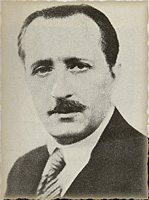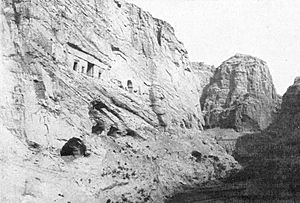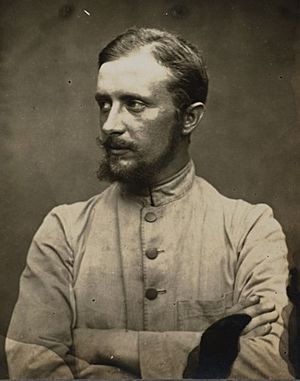Paul Pelliot facts for kids
Quick facts for kids
Paul Pelliot
|
|||||||||||
|---|---|---|---|---|---|---|---|---|---|---|---|

Paul Pelliot
|
|||||||||||
| Born | 28 May 1878 |
||||||||||
| Died | 26 October 1945 (aged 67) Paris, France
|
||||||||||
| Known for | Dunhuang manuscripts discovery | ||||||||||
| Scientific career | |||||||||||
| Fields | Chinese history | ||||||||||
| Institutions | Collège de France École Française d'Extrême-Orient |
||||||||||
| Academic advisors | Édouard Chavannes Sylvain Lévi |
||||||||||
| Notable students | Paul Demiéville | ||||||||||
| Chinese name | |||||||||||
| Chinese | 伯希和 | ||||||||||
|
|||||||||||
Paul Eugène Pelliot (born May 28, 1878 – died October 26, 1945) was a French expert in Chinese and Asian studies. He is famous for exploring Central Asia and finding many important Chinese writings. These writings are known as the Dunhuang manuscripts.
Contents
Paul Pelliot's Early Life and Studies
Paul Pelliot was born in Paris, France, on May 28, 1878. He first wanted to become a diplomat for his country. To prepare, he studied English at La Sorbonne. Then, he learned Mandarin Chinese at the School of Living Oriental Languages.
Paul was a very talented student. He finished a three-year Chinese course in just two years. His quick learning caught the eye of Édouard Chavannes, a famous Chinese expert. Chavannes taught Paul and introduced him to Sylvain Lévi, who taught Sanskrit. Both teachers encouraged Paul to become a scholar instead of a diplomat.
In 1900, Paul moved to Hanoi to work at the French School of the Far East (EFEO). He was sent to Peking (now Beijing) to buy Chinese books for the school's library.
Paul Pelliot During the Boxer Rebellion
In July and August 1900, Paul was in Peking during the Boxer Rebellion. This was a time when a group of Chinese people rebelled against foreign influence. Foreigners were trapped in their buildings. During a break in the fighting, Paul bravely went to the rebels' camp. He used his good Mandarin skills to get fresh fruit for the people stuck inside. For his courage, he received a special award called the Legion of Honour. In 1901, when he was only 23, Paul became a professor of Chinese at the EFEO.
Paul stayed in Hanoi until 1904. He then returned to France to get ready for a big meeting of Asian experts in Algiers. While in France, he was chosen to lead an important trip. This trip was to explore Chinese Turkestan, a region in Central Asia.
Exploring Central Asia
Paul Pelliot's team left Paris on June 17, 1906. His team had three members: Dr. Louis Vaillant, a doctor, and Charles Nouette, a photographer. On their journey, they met Baron Gustaf Mannerheim, a Russian army officer. Mannerheim joined their group, pretending to be a collector. He was actually on a secret mission for the Russian Tsar.
Paul Pelliot was very skilled with languages. By the time his trip reached Dunhuang, he had learned many languages. These included Mongolian, Arabic, Persian, Turkic languages, Tibetan, and Sanskrit. These skills were very helpful when he looked at the many different texts found in the Mogao caves.
Discoveries in Dunhuang


The expedition traveled through Moscow and Tashkent to Andijan. From there, they rode horses and carts across mountains to China. They arrived in Kashgar in August. Paul surprised local Chinese officials with his fluent Chinese. He spoke 13 languages in total! This helped his team get supplies they needed.
Paul's first stop after Kashgar was Tumxuk. Then he went to Kucha, where he found old documents in a language called Kuchean. His former teacher, Sylvain Lévi, later translated these. After Kucha, Paul went to Ürümqi. There, he met Duke Lan, who told him about old writings found in the Silk Road city of Dunhuang.
Paul quickly went to Dunhuang. However, another explorer, Aurel Stein, had already visited the site months before.
At Dunhuang, Paul was able to enter a secret room belonging to a monk named Abbot Wang. This room held a huge collection of old writings from the Middle Ages. Aurel Stein had seen these writings in 1907 and bought many of them. But Stein did not know Chinese, so he could not choose the most important documents.
Paul, however, knew Chinese very well, along with many other Central Asian languages. He spent three weeks in April 1908 quickly looking through the writings. Paul chose what he thought were the most valuable ones. Abbot Wang agreed to sell them to Paul for 500 taels. This was a lot of money, about $11,000 in 2014.
Paul Pelliot's Return to France
Paul Pelliot returned to Paris on October 24, 1909. Some people did not believe his amazing discoveries. While in Dunhuang, Paul had written a detailed report about the valuable documents he found. He sent it back to Europe, and it was published. In his report, Paul included many facts and dates from the writings. He had remembered these details after only looking at the documents for a few minutes.
This was so impressive that some people thought he had made up the documents. They accused him of wasting public money and bringing back fake writings. These accusations were proven false in 1912. That year, Aurel Stein published his book, Ruins of Desert Cathay. In his book, Stein confirmed Paul's stories. He also said that he had left many writings behind in Dunhuang after his own visit. This showed that Paul was telling the truth and silenced his critics.
In 1911, Paul Pelliot was recognized for his wide knowledge. The Collège de France made him a professor and created a special teaching position just for him. This position was for the Languages, History, and Archaeology of Central Asia. Paul was the only person to ever hold this special role.
From 1920 to 1942, Paul helped edit a very important journal about Chinese studies called T'oung Pao. He died of cancer in 1945. People said that without him, the study of Chinese culture was like an orphan.
Today, the Guimet Museum in Paris has a gallery named after Paul Pelliot.
Images for kids
See also
 In Spanish: Paul Pelliot para niños
In Spanish: Paul Pelliot para niños








